6170RB Science A STEM approach Foundation low res watermark
Create successful ePaper yourself
Turn your PDF publications into a flip-book with our unique Google optimized e-Paper software.
Lesson 1<br />
Biological sciences<br />
LIVING THINGS HAVE NEEDS<br />
Teacher notes<br />
<strong>Science</strong> inquiry focus:<br />
What basic needs do all living things have in common?<br />
<strong>Science</strong> Inquiry Skills:<br />
• Questioning and predicting QP<br />
• Planning and conducting PC<br />
• Processing and analysing data and information PA<br />
• Communicating<br />
C<br />
<strong>Science</strong> as a Human Endeavour:<br />
• Students learn how to identify living from non-living things<br />
in the environments they encounter in their everyday lives.<br />
Technology/Engineering/Mathematics links:<br />
• viewing digital texts including images and videos<br />
• playing an interactive game online<br />
• recording information in a table<br />
Background information<br />
• Living things have characteristics that distinguish<br />
them from non-living things. Living things grow, move,<br />
<strong>res</strong>pond to stimuli, reproduce and are dependent on<br />
their environment. These characteristics are explored by<br />
students in detail in Year 3.<br />
• In <strong>Foundation</strong> level, most students would suggest that<br />
living things grow and move. Some may suggest that they<br />
reproduce/have babies. This is sufficient at this level.<br />
• All living things, including humans, plants and other<br />
animals, have basic needs. While these needs vary slightly<br />
among each, the common needs are air, food and water.<br />
Meeting these physical needs al<strong>low</strong>s the living thing to<br />
move and grow.<br />
• Other needs that vary among living things include: shelter,<br />
protection, love, clothing/coverings, correct environmental<br />
conditions, soil and sunlight. These will be explored in<br />
later lessons.<br />
• For more information about teaching the concept of living<br />
things, go to .<br />
Assessment focus:<br />
• Use page 7 as a diagnostic<br />
assessment of the student’s<br />
knowledge of living and nonliving<br />
things and the three basic<br />
needs of all living things.<br />
• Make observational notes of the<br />
student’s ability to answer the<br />
two communicating questions<br />
in the Reflection section.<br />
Resources<br />
• Digital cameras<br />
• One copy of page 6 to<br />
display on the interactive<br />
whiteboard<br />
• One copy of page 7 for<br />
each student or each group<br />
• Online image—Basic<br />
needs of all living things<br />
at <br />
• Online song—'Living<br />
and non-living things'<br />
at <br />
© R.I.C. Publications<br />
Low <strong>res</strong>olution display copy<br />
4 <strong>Science</strong>:<br />
A <strong>STEM</strong> APPROACH<br />
YEAR<br />
F<br />
978-1-925431-93-3 R.I.C. Publications® – www.ricpublications.com.au


















